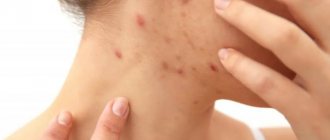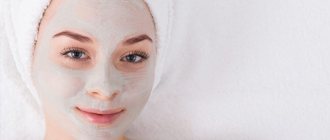Painful pimples* on the face: the cause of pain in women and men
Acne can be non-inflammatory (open, closed comedones) and inflammatory (papules, pustules, cysts, etc.). Non-inflammatory acne elements, as a rule, only cause aesthetic discomfort, but inflammatory acne elements can cause pain.
The inflammatory process is the primary link in the pathogenesis of acne. It can develop even without the participation of propionibacteria. Inflammation of the pilosebaceous follicle provokes hyperkeratosis, obstruction of the sebaceous gland channels19.
Neutrophilic leukocytes are attracted to the site of inflammation, which contributes to the formation of papules and pustules. The vessels around the inflamed area dilate, and swelling of the follicle appears. It can be felt by palpation, but pain can be felt even if you do not touch the elements of the acne.
Many people think that by squeezing a pimple they will relieve themselves of unpleasant sensations. But when the follicle is destroyed, the contents of the pustule (sebum, pus, fatty acids) enter the deep layers of the skin. These substances provoke irritation and new inflammation, which affects surrounding tissues. As a result, you may notice the rash spreading even more.
Medicines to relieve pain and treat painful acne
These pain relief and pimple treatment medications are actually designed to kill bacteria on the surface and deep within the skin, which helps reduce acne infection. Cysts and pimple pain, however, require a product that can be absorbed deeply and completely into the skin. One of the few available on the market is Ovante cream and Akriderm cream, whose lactic acid-based formula acts as an anti-inflammatory drug against pimple pain and inflammation. Another plus: such creams reduce the recovery time from these unpleasant eruptions of papules and quickly remove the feeling of pain from them.
What you really need is a combination of topical creams that help soothe the inflammation that causes the painful pimple, and treatments to treat the underlying cause of the pimple, which you must determine through diagnosis, testing, and a facial examination by your dermatologist. , naturally, will be able to prescribe you such a parallel remedy to treat bacteria under the skin for acne.
In dermatological practice, treatment of this stage of acne using salicylic acid, benzoyl peroxide and cortisone is often recommended. Start by treating painful pimples with a 2% salicylic acid solution.
This beta hydroxy acid helps remove oil from the surface of the skin and quickly eliminate the pain and inflammation of a pimple. Also, through regular daily facial skin treatment with benzoyl peroxide, the product kills the main bacteria that causes acne, P acnes.
Finally, after using salicylic acid, you can apply a 1% layer of Quatlan hydrocortisone cream to your skin, which also helps reduce inflammation and relieve pain from a pimple.
Painful pimples* on the face: causes and treatment
Painful rashes appear for a number of reasons, here are some of them48,49:
- Changes in hormonal levels. This is especially common among girls before menstruation and adolescents during puberty.
- Poor nutrition. Excess dairy products, fatty, sweet foods.
- Mistakes in hygiene. Its excess or deficiency.
- Genetic predisposition. A family history of acne increases the likelihood of developing acne.
- Taking certain medications. Glucocorticosteroids and some other medications can cause acne.
A dermatologist treats acne. For mild to moderate acne, the doctor may prescribe medications with azelaic acid, for example, Azelik®5,9 gel. It should be applied to previously cleansed, dry skin5. The doctor may also recommend combination therapy: the use of Azelik® gel and Clindovit® gel (topical antibiotic).
*acne
Effective Treatments for Severely Painful Acne
You can also treat your existing cystic acne by not only eliminating the pain and inflammation of the pimple, but also completely getting rid of any pimples, including painful ones, with the LED Light Pimple Removal Treatment, in which “Blue LED light is an amazingly effective bacteria-killer.” under the skin of the face. A light chemical peel with lactic acid that can be done at home.
It is usually not as effective as the deeper acne treatment of LED acne removal, but it can be an effective treatment option for some people on a budget who prioritize home treatments over in-office treatments.
Use a gentle, balanced cleansing soap. Wash your face twice a day, morning and evening, and after exercise or any physical activity. Remember to also cleanse the areas under your jaw, all the way down to your hair, and then rinse thoroughly.
- If you don't have sensitive skin and your skin has an oily undertone, choose an acne cleanser that contains benzoyl peroxide or salicylic acid.
- Strong soaps, scrubbing pads or rubbing your skin have not been shown to help and can irritate your skin and make your acne worse.
- Wash your hair daily to control oil production from the sebaceous glands located on the scalp.
Varieties
Skin rashes come in different types. Some of them are painful and dangerous, others are more likely to cause cosmetic discomfort. The color of the formations is also different: from white and pink to black. Conventionally, they are divided into inflammatory and non-inflammatory. The latter include open and closed comedones. And there are many more types of first rashes. These are superficial, nodular and purulent pustules, cystic nodules, subcutaneous pimples on the chin, the causes of which can be found out by accurately determining the type of rash.
Let's talk in more detail about the main types.
Open and closed comedones
The first are plugs that arise in the ducts of the exocrine glands. Outwardly, they look like black dots. Their color ranges from light gray to dark brown. The fatty contents darken due to oxygen exposure.
Closed comedones are non-inflamed bumps that are located under the epidermis. The color of the rash is flesh-colored. They are not always noticeable, but can be felt with your fingers. Such internal pimples on the chin in women cannot be squeezed out, the reasons for this are simple: independent “treatment” of the skin and extraction of the contents leads to the appearance of scars and signs of post-acne.
Papules and pustules
The first are cavityless nodules located above the skin. They have a dense or soft consistency. Pustules are purulent cavity elements with a white head and liquid contents.
Papules may be superficial, appearing as red, outlined dots, or nodular. The latter differ in the size and presence of the inflammatory focus. Such internal pimples on the chin are painful on palpation; the cause may lie in inflammation of the hair follicle. No obvious purulent contents are observed.
Subcutaneous acne
An annoying problem that is difficult to deal with due to the fact that the source of inflammation is located deep under the dermis. The rashes are painful, take a long time to mature, and if you try to squeeze them out, traces remain in the form of fistulas, redness and even scars. It is difficult to quickly cure such a problem. Diagnostics, including laboratory tests, is of great importance.
Why do large or small internal pimples appear on the chin? There are several factors:
- endocrine disorders;
- disruptions in the gastrointestinal tract;
- decreased immunity;
- autoimmune diseases;
- frequent deep peeling;
- demodex.
Pink and whiteheads
Another variety is very similar in name, but very different in origin. It is a mistake to believe that rosacea and whiteheads differ only in color.
The first rash is characteristic of rosacea, a chronic dermatological disease. It is manifested by dilated capillaries, redness, swelling, as well as the presence of papules and pustules. Why such subcutaneous pimples appear on the chin is not entirely clear. The progression of the disease is influenced by hereditary factors, disturbances in vascular tone, and changes in the functioning of the sebaceous glands.
Whiteheads are otherwise called milia, prosyanki or retention cysts. Outwardly, they look like small light subcutaneous nodules. The inside is filled with keratin mixed with sebum. The formations do not hurt or become inflamed unless they are injured. Their usual localization is the eyelids, T-zone and area around the eyes.
Skin and age
Acne often bothers middle-aged people, when the first wrinkles already appear, but the “problematic” skin still persists. The reasons are age-related thickening of the skin, decreased local immunity and endocrine disorders. At this age, acne is located mainly along the oval of the face and on the cheeks, where thin convoluted glands lie.
What to do?
The optimal result is achieved by combining peeling with mesoimmunocorrection. Mesoimmunocorrection is the use of mesotherapy products with hyaluronic acid, vitamins, amino acids that stimulate the skin’s immunity, promote its hydration, and enhance local metabolism and blood circulation. The combination of these methods not only has anti-acne effectiveness, but also helps prevent age-related changes. The skin becomes more elastic, smooth and fresh, which is important for most patients over the age of 30.
Attention! A radical remedy that permanently or permanently reduces the secretion of the sebaceous glands and thins the upper parts of the skin (and therefore cures acne) is the vitamin A drug Roaccutane, which is taken daily for several months and has a cumulative effect. However, you should not delude yourself and self-medicate. This drug is indicated only in cases of severe or moderate disease, and its use requires a preliminary examination. It has contraindications and can sometimes be tolerated with the development of dry skin or other manifestations that are eliminated by certain therapeutic measures. Treatment should be carried out under the supervision of a physician and against the background of regular evaluation of blood tests.
What to do if you have acne?
25.08.2021
Acne spoils the appearance of the face and also causes a lot of inconvenience to the owner. Firstly, acne looks terrible (but you shouldn’t be afraid or ashamed of it). Secondly, acne can be very painful. Thirdly, squeezing pimples is a very unpleasant thing.
Girls are already accustomed to the fact that before an important event a pimple will always pop up in some prominent place. However, this is a one-time event. And there are people who constantly suffer from a large number of rashes. And here the question arises: “What to do? How to get rid of them?
Let's start with the definition of acne .
What is acne?
Acne is a common skin disease that affects those areas of the skin where the largest number of sebaceous glands are concentrated.
Who is susceptible to such diseases?
Acne is the most popular disease among teenagers. After 25-26 years, the likelihood of acne decreases to 13 percent.
Causes of acne
Firstly, you need to understand one thing once and for all - acne never appears just like that, because it is a skin disease, and it always has its own reasons. And the appearance of acne on the nose does not mean that someone has certainly fallen in love with its owner. The main causes of acne :
- hormones : acne can appear in the premenstrual period, and often long-term skin diseases can appear due to hormonal imbalance;
- poor diet: acne occurs due to the consumption of low-quality foods. Again, there are individual intolerances to certain foods;
- allergies : allergic reactions are always accompanied by acne ;
- improper cosmetic care: many girls choose the wrong skincare products, which can cause acne . This is only possible for two reasons: the composition of the cosmetic product irritates the skin, so this is its usual reaction to an external irritant, or it may be an individual intolerance to individual components;
- stress: during prolonged stressful situations, sebum production increases;
- hygiene: how often do you forget to wash your face in the evening? Or how often do you change your pillowcases? Do you have a separate face ? Do you often touch your face with dirty hands? All this also affects the condition of the skin;
- long-term treatment: with long-term use of medications, the body begins to release harmful substances through the skin - it is difficult for the body to cleanse itself.
How to deal with acne?
In fact, the duration of treatment depends on many factors. Here it is worth taking into account your skin type, the stage of the disease, and the type of acne .
- Start practicing hygiene: do not neglect proper cleansing and care of your skin, do not touch your face with your hands, dry yourself with a clean towel, or even use only paper towels.
- Review your diet: analyze what constitutes the basis of your diet. Think carefully - after consuming which specific products acne worsens , try to exclude such a product and observe the changes.
- You should pay attention to both skincare cosmetics and regular cosmetics. Perhaps something doesn't suit your skin.
- Minimize worries and stress in the body, be less nervous.
- You can purchase special cosmetics designed to combat acne , which are selected according to your skin type.
- You can contact a doctor , who will prescribe tests to identify the exact diagnosis and problem, and then the specialist will select the correct treatment, which will be aimed at combating the source of the disease.
In fact, slow treatment, but effective, is better than fast, but short-lived treatment.
Thus, there are quite a lot of methods to combat acne , but it is not always possible to quickly find an effective treatment. Through mistakes and trials, you can find something that will help you get rid of the skin disease.
Published in Dermatology Premium Clinic









